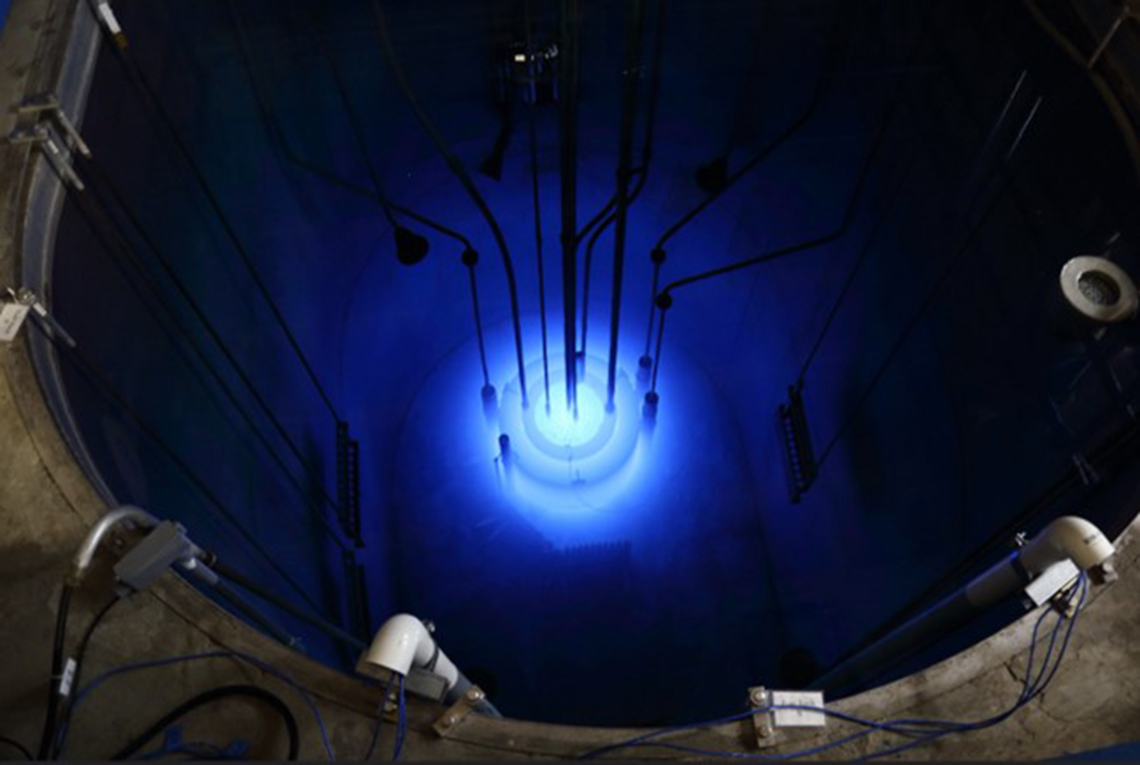
If you would like to learn more about the IAEA’s work, sign up for our weekly updates containing our most important news, multimedia and more.
Neutrons Save Lives
Research reactors for production of medical isotopes and radiopharmaceuticals
Amirreza Jalilian, Mary Albon

A research reactor core irradiating a target for medical radioisotope production at Reed College in the United States of America. (Photo: D. McCullough/Flickr)
The efficient production of medical radioisotopes and the development of new radiopharmaceuticals are leading to better diagnoses and more effective therapies for many types of cancer and other diseases. As a result, the demand for radioisotopes, which are mainly produced using research reactors or accelerators, is continuing to grow, and the number of radiopharmaceuticals in clinical use is increasing rapidly.
“ Our ultimate goal is to help increase global production of these essential tools for nuclear medicine and bridge gaps in access in some regions, so that vulnerable people with cancer and other life threatening diseases can receive the care they need."
“Medical radioisotopes and radiopharmaceuticals can be lifesaving when they are prepared and administered appropriately,” said Melissa Denecke, Director of the IAEA Division of Physical and Chemical Sciences.
Medical radioisotopes are radioactive elements that, when attached to specific molecules in pharmaceutical formulations, emit radiation that is easily traceable, which makes them useful for medical diagnostics. They can also be used for therapeutic purposes, targeting tumour tissue to treat cancers, such as those of the prostate, breast or intestine.
Radiopharmaceuticals are drugs that combine a medical radioisotope with a biologically active molecule. Diagnostic radiopharmaceuticals containing radioisotopes that emit gamma radiation can target specific organs, tissues or cells. They are administered to patients through injection, inhalation or orally to produce images of the targeted organs or tissues using a non-invasive external camera that detects gamma rays. Therapeutic radiopharmaceuticals contain particle-emitting radioisotopes that accumulate in target tissues to kill cancerous cells.
Research reactors are the major source of medical radioisotope production, including molybdenum-99 (Mo-99), iodine-131 (I-131) and holmium-166 (Ho-166), among others. I-131, which is used to diagnose and treat thyroid cancer, was one of the earliest radioisotopes produced in a research reactor in the early 1940s. Although around 35 medical radioisotopes are produced, Mo-99 accounts for the major share. It is the parent isotope of technetium-99m (Tc-99m), which is used in about 85 per cent of nuclear medicine procedures worldwide for the diagnosis of cancers and heart, brain and bone diseases — that is up to 50 million nuclear medicine procedures per year.
Lutetium-177 (Lu-177) is another important research reactor-based radioisotope. “Lu-177 is the mainstay for the production of therapeutic radiopharmaceuticals used to treat people with bone pain and prostate, stomach and intestinal cancers,” said Renata Mikołajczak, a researcher at Radioisotope Centre POLATOM at Poland’s National Centre for Nuclear Research. “At least 20 new drugs using Lu-177 are in the pipeline worldwide.”
In May 2023, the IAEA launched a coordinated research project to develop new radiopharmaceuticals for cancer therapy using Lu-177. “Recent developments in Lu-177-based radiotherapeutics have transformed treatment management for neuroendocrine tumours and prostate cancers — with better outcomes for patients,” said Aruna Korde, an IAEA radiopharmaceutical scientist. “However, gaps remain in our understanding of the biological behaviour of Lu-177-labelled therapeutic radiopharmaceuticals,” she added. The coordinated research project aims to identify and address factors that may limit the efficacy of these radiotherapeutics. It will develop and carry out the preclinical evaluation of Lu-177 radiopharmaceuticals to assess their potential for targeting some of the major cancers. It will also provide guidelines for radiolabelling and for the quality, safety and efficacy evaluation of Lu-177-based radiopharmaceuticals.
Radioisotope production
Forty countries have research reactors capable of producing radioisotopes; of those, around 25 are actively producing radioisotopes for medical applications. In most cases, radioisotopes are produced for the domestic market. A smaller number of countries export radioisotopes to the regional or world market, and a select number of countries export in large quantities. The IAEA provides knowledge and expertise to countries around the world on how to use research reactors to develop and manufacture these crucial tools for diagnosis and treatment. Research reactors provide a safe and stable source of important isotopes for medical applications, including radiopharmaceuticals, but also radioisotope therapeutic sources, like brachytherapy, and the sterilization of medical devices.
Demand continues to grow. “There is still a long way to go to meet the increasing demand for research reactor-based radioisotopes,” said Bernard Ponsard, Radioisotopes Project Manager at the Belgian Nuclear Research Centre, known as SCK CEN.
The IAEA supports countries in the production of radioisotopes using research reactors not only for medical uses, but also for industrial and research and development purposes. It develops guidance publications, convenes technical meetings for the exchange of information and know-how, organizes coordinated research projects involving research institutions in multiple countries, and promotes capacity building through training activities, scientific visits and fellowships. Through its technical cooperation programme, the IAEA also supports individual countries and promotes regional and interregional projects.
“The IAEA is building and nurturing a community of professionals around the globe who are able to produce radioisotopes and safe, high-quality radiopharmaceuticals,” Denecke said. “Our ultimate goal is to help increase global production of these essential tools for nuclear medicine and bridge gaps in access in some regions, so that vulnerable people with cancer and other life-threatening diseases can receive the care they need.”
Related Resources
- Production, Quality Control and Clinical Applications of Radiosynovectomy Agents
- Pain Palliation of Bone Metastases: Production, Quality Control and Dosimetry of Radiopharmaceuticals
- Health
- Cancer
- Diagnostic radiopharmaceuticals
- Radiopharmaceuticals - A Key Component of Nuclear Medicine
- How Radiopharmaceuticals Help Diagnose Cancer and Cardiovascular Disease
- How IAEA Technical Cooperation projects work
- Radioisotope Products and Radiation Technology Section
- Radiopharmaceuticals, IAEA Bulletin (Vol. 13-1, February 1971)
- Nuclear Medicine - a New Discipline, IAEA Bulletin (Vol. 8-2, June 1966)





